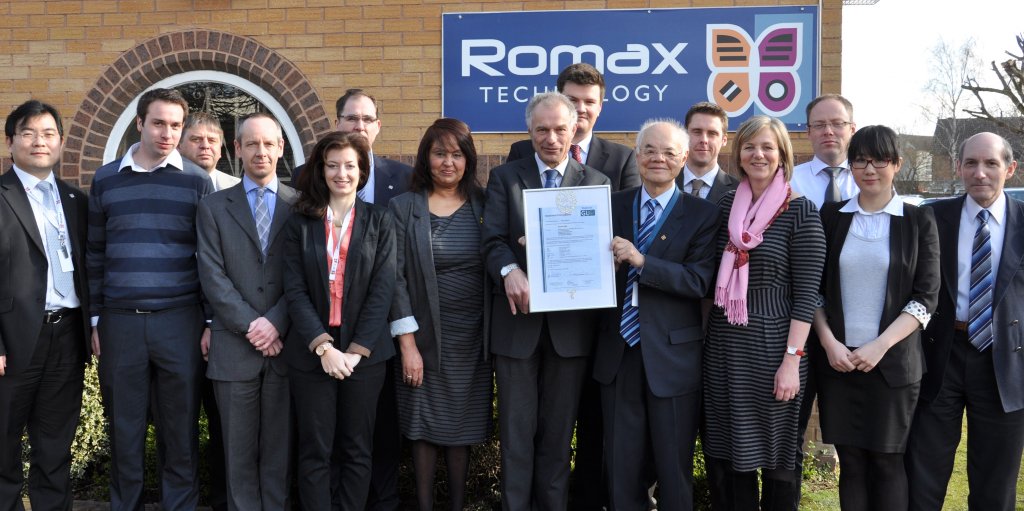Renewable Certification body Germanischer Lloyd (GL) recently held a ceremony with Romax Technology to celebrate the significant achievement of the 25th GL Statement of Compliance (A-Design Assessment Certification) over the last three years. The ceremony, held at Romax’ HQ in Nottingham, England on Wednesday, April 3rd 2013, involved key members of the Romax project team who have been involved in the design and development of gearboxes. Key members of GL including Dr Karl Steingroever will award Romax the 25th A-Design Certificate and celebrate its working relationship in supporting the global wind market in achieving a world leading engineering standard.

A few guests in attendance included (far left) Dr. Xiaobing Hu from Romax Technology, James Lowther from Moonray Energy, Mandy Rait from UK Trade & Investment, Dr. Karl Steingroever and Robert Kasch from Germanischer Lloyd, CEO of Romax Technology Dr. Peter Poon, and MP and Shadow Transport Minister Lilian Greenwood.
“Romax is recognised by GL as the first company in the world to achieve 25 Gearbox designs with A-Design Certificates,” says Steingroever. “The Romax’ team of industry experts have developed reliable and accurate engineering processes, backed by technological experience, from planning through to certification, which means they consistently achieve this difficult challenge, quickly and expertly.”
Romax has a track record of over 20 years engineering experience, along with advanced tools in developing gearbox and drivetrain designs and working closely with government, industry and the major certification bodies. The company has a total of 29 gearbox designs in production of which 25 are GL certified for wind turbines from 1.5 to 5 MW and up.
Director of the Drivetrain Business Unit at Romax Technology, Dr Xiaobing Hu, said “Romax has worked with GL in establishing a close-working collaboration. We have benefited from their guidance and have invested the time to understand and comply with the latest thinking in standards. Our experienced engineers together with our design expertise, software tools, and consultancy services have let us develop a compressed, rapid response development cycle. That has reduced the total time of the normal process by more than 70% while ensuring designs successfully exceed international standards. This makes our certification process right first time, which is crucial for our customers as it means reduced design costs and a faster time to market.’
As part of its on-going investment in drivetrain development, Romax uses state-of-the-art design and analysis techniques supported by its RomaxDESIGNER for wind, simulation software. This software is the only one certified by GL for gear calculations to design and analyse drivetrains to certification standards. This is supported, says the company, by its lifecycle engineering services including manufacturing assessment and support, technical training, operations and maintenance services and its advanced predictive maintenance tools.
Romax Technology
Filed Under: Events, News





Thanks to Mike Agrelius for his comments. I have responded to him by email.
Great article on a company that deserves the accolades. Paul Dvorak does another outstanding job. Equally impressive is the very innovative thinking of George Fleming’s detailed comment. I invite you, George (Paul Dvorak, and others) to visit me at my poster presentation at AWEA next month where I will outline one way to address the variable wind speed concern and eliminate the power electronics, as George mentions. The scientific poster title is “Thinking Outside the [Gear]Box: Understanding the Value Proposition of CVTs.” A positively engaged CVT would also lend itself to some of the other creative thinking Mr. Fleming discussed in his outstanding comment below, and something I hope Romax will consider for the future. I would love to meet with Dr Xiaobing Hu from Romax and George Fleming to discuss this concept more completely.
Romax is no doubt an excellent company. But it could transform the wind power industry if it would discard the narrow, conventional mindset regarding wind turbine drive trains and focus on the following:
1. Put the main gearbox and generator at the base of the tower. This would greatly reduce tower top weight and the cost of erection and maintenance. Transfer of power from tower top to base through the vertical drive shaft would also eliminate the shock to the drive train from wind gusts, because the drive shaft would act as a torsional spring. The job of partially supporting the weight of the rotor would be removed from the gearbox, eliminating the gear case distortion that is another cause of early failure.
2. Design the drive train to convert the variable wind speed to constant speed for the generator. This would eliminate the power electronics, which are complicated , delicate and expensive. They waste energy and cannot produce pure, clean sine wave power. No generator arrangement using power electronics will ever equal the constant speed synchronous type.
3. Abandon the notion that the planetary design is the only one that will work in wind turbines. The multi-branch parallel shaft design is better in every respect. There can be perfect power sharing between the branches. Power density, efficiency and reliability are at least as good. It costs less.
The wind power industry would be further transformed for the good if it concentrated on compressing air to storage for later use. For instance, solar power could be greatly expanded with a reliable source of compressed air. Solar-powered air conditioning is also practical. This alone would greatly reduce the electrical demand, the benefits of which are obvious. Compressing air with wind turbines would eliminate the disadvantage of variability in the power of the wind.
With these improvements, gearboxes and wind power would be in much greater demand, Romax would be even more important, and the folly of using direct drive wind turbines to produce electrical power would be at last be recognized.